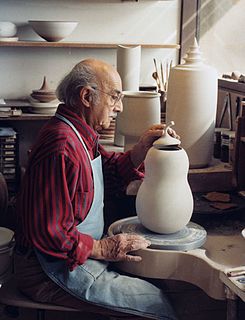Paul Edmund Soldner was an American ceramic artist and educator, noted for his experimentation with the 16th-century Japanese technique called raku, introducing new methods of firing and post firing, which became known as American Raku. He was the founder of the Anderson Ranch Arts Center in 1966.

Peter Voulkos was an American artist of Greek descent. He is known for his abstract expressionist ceramic sculptures, which crossed the traditional divide between ceramic crafts and fine art. He established the ceramics department at the Los Angeles County Art Institute and at UC Berkeley.

Daniel Rhodes was an American artist, known as a ceramic artist, muralist, sculptor, author and educator. During his 25 years (1947–1973) on the faculty at the New York State College of Ceramics at Alfred University, in Alfred, New York, he built an international reputation as a potter, sculptor and authority on studio pottery.

Studio pottery is pottery made by professional and amateur artists or artisans working alone or in small groups, making unique items or short runs. Typically, all stages of manufacture are carried out by the artists themselves. Studio pottery includes functional wares such as tableware and cookware, and non-functional wares such as sculpture, with vases and bowls covering the middle ground, often being used only for display. Studio potters can be referred to as ceramic artists, ceramists, ceramicists or as an artist who uses clay as a medium.
Joan Takayama-Ogawa is a sansei (third-generation) Japanese-American ceramic artist and currently professor at Otis College of Art and Design in Los Angeles, California. Takayama-Ogawa's heritage since the 15th century of Japanese ceramic art influences her work, that usually explores beauty, decoration, ornamentation and narrative while also introducing a dialogue that rejects the traditional role of women in Japanese culture. Her most recent work addresses issues like climate change.
Akio Takamori was a Japanese-American ceramic sculptor and was a faculty member at the University of Washington in Seattle, Washington.
Toshiko Takaezu was an American ceramic artist, painter, sculptor, and educator who was known for her rounded, closed forms that viewed ceramics as a fine art and more than a functional vessel. She is of Japanese descent and from Pepeeko, Hawaii.
D. Wayne Higby is an American artist working in ceramics. The American Craft Museum considers him a "visionary of the American Crafts Movement" and recognized him as one of seven artists who are "genuine living legends representing the best of American artists in their chosen medium."
Adrian Saxe is an American ceramic artist who was born in Glendale, California in 1943. He lives and works in Los Angeles, California.
Peter Shire is a Los Angeles-based artist. Shire was born in the Echo Park district of Los Angeles, where he currently lives and works. His sculpture, furniture and ceramics have been exhibited in the United States, Italy, France, Japan and Poland. Shire has been associated with the Memphis Group of designers, has worked on the Design Team for the XXIII Olympiad with the American Institute of Architects, and has designed public sculptures in Los Angeles and other California cities. Shire has been honored by awards for his contribution to the cultural life of the City of Los Angeles.

Kintsugi, also known as kintsukuroi, is the Japanese art of repairing broken pottery by mending the areas of breakage with lacquer dusted or mixed with powdered gold, silver, or platinum; the method is similar to the maki-e technique. As a philosophy, it treats breakage and repair as part of the history of an object, rather than something to disguise.
Tsujimura (辻村) is a Japanese surname. Notable people with the surname include:
Edris Eckhardt was an American artist associated with the Cleveland School. She is known for her work in Ceramic art and glass sculpture, her work with the Works Projects Administration's (WPA) Federal Arts Project of Cleveland, and her teaching.
Sueharu Fukami is a Japanese ceramic artist and sculptor known for his work in pale-blue qinbai porcelain. Fukami's abstracted, sculptural ceramic works depart from the traditional Japanese artisan traditions of his upbringing and instead explore natural phenomena and universal senses like "infinite space" through sharp silhouettes, sweeping curves, architecturally-inspired arches, and delicately-colored glaze. His minimalist approach to porcelains has contributed to defining and expanding the meaning, importance, and popularity of contemporary Japanese ceramics beyond craft art circles, most notably to fine art collectors and museums globally.
Masaya Imanishi is a Japanese ceramic artist.

Harrison Edward McIntosh was an American ceramic artist. He was an exponent of the Mid-century Modern style of ceramics, featuring simple symmetrical forms. His work has been exhibited in venues in the United States including the Smithsonian and internationally including at the Louvre in France.
Harris Deller is an American ceramist. He is well known for his black and white incised porcelain.
Richard Shaw is an American ceramicist and professor known for his trompe-l'œil style. A term often associated with paintings, referring to the illusion that a two-dimensional surface is three-dimensional. In Shaw's work, it refers to his replication of everyday objects in porcelain. He then glazes these components and groups them in unexpected and even jarring combinations. Interested in how objects can reflect a person or identity, Shaw poses questions regarding the relationship between appearances and reality.
Kurt Weiser is an American ceramicist and professor. His work—explorations of the relationship between man and nature through narratives rendered in vivid color—are described as "Eden-like." His work has often taken the form of teapots, vases, and cups, though he has recently begun crafting globes as well. Weiser is currently the Regents Professor at Arizona State University's School of Art.
Chris Gustin is an American ceramicist. Gustin models his work on the human form, which is shown through the shape, color, and size of the pieces.




